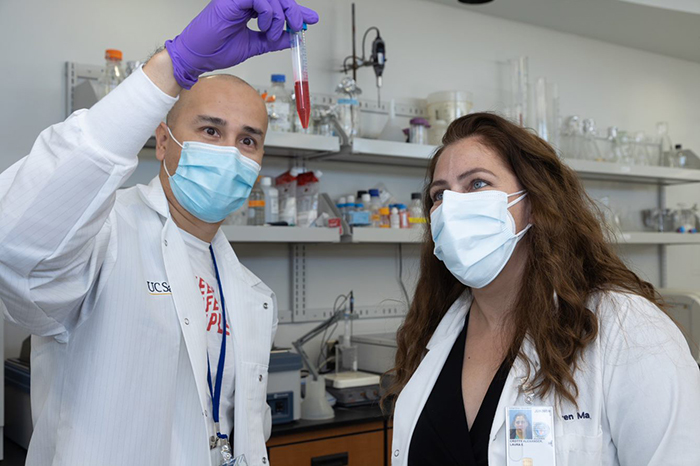Office of Research & Development |
 |


Dr. Laura E. Crotty Alexander (right) and Dr. Jorge Masso-Silva have led efforts to define the long-term consequences of e-cigarette use. (Photo by Kevin Walsh)
February 15, 2022
By Tamar Nordenberg
For VA Research Communications
"It has become clear to me that e-cigarettes cause their own set of diseases that seem to impact just about every organ in the body—from the brain to the bladder."
As a physician with the VA San Diego Healthcare System, Dr. Laura E. Crotty Alexander has heard from more and more patients over recent years that they’re thinking of switching to vaping e-cigarettes as a safe alternative to traditional cigarettes. Not so fast, says the pulmonologist, who is also an associate professor at University of California San Diego. She calls it a “dangerous situation,” with so many people apparently unaware that e-cigarettes come with wide-ranging dangers of their own.
While some tout e-cigarettes as a solution to quitting conventional smoking, the truth about relative risks is complicated, says Crotty Alexander, who is a researcher in addition to providing patient care and teaching. In a major recent undertaking to help clarify the effects of e-cigarettes, the physician-investigator conducted a review of the best available evidence about vaping and lung harms. She and her co-authors published their roundup of the evidence in an article titled “Vaping and Lung Inflammation and Injury,” which appeared online Feb. 10 in the journal Annual Review of Physiology.
As substantiated in the review, a convincing body of evidence exists that confirms e-cigarettes cause lung inflammation and injury, as well as negative health effects in multiple organs. Crotty Alexander says e-cigarettes come with far more dangers than even she expected.
“I initially believed, in my heart of hearts, that nothing could compare to the dangers of smoking conventional tobacco. Over eight years of research, and as affirmed by this new review of the evidence, it has become clear to me that e-cigarettes cause their own set of diseases that seem to impact just about every organ in the body—from the brain to the bladder.”

The Crotty Alexander lab buys a variety of e-cigarette and vaping devices and e-liquids to parallel what the general population is using and generates aerosols from them. In the photo, the aerosol from a pod-based e-cigarette containing lab-mixed e-liquid to mimic unflavored JUUL is drawn up into a sterile syringe containing media to create e-cigarette vape extract. (Photo by Kevin Walsh)
E-cigarettes are devices that use an electric battery to heat up a liquid (commonly called an “e-liquid”) into an aerosol, which the user inhales. The popular devices—used by about 9% of people in the United States, including some 2 million middle and high school students—generally contain nicotine or THC (the psychoactive chemical in marijuana), flavorings, and other chemicals dissolved in an oily liquid base. Vitamin E acetate, diacetyl, formaldehyde, and acrolein are just a few among hundreds of potentially hazardous substances commonly found in e-liquids and their aerosols.
The dangers of traditional cigarettes—such as immensely increased risks of lung cancer, stroke, and heart attack from regular smoking—are widely known. While e-cigarettes are much newer on the scene and researchers are building the evidence base, studies have already uncovered some serious dangers. Given vaping’s popularity, Crotty Alexander says “it is imperative to answer outstanding questions about e-cigarettes’ impact on the body as soon as possible, to accurately inform the public, health care providers, and policymakers.”
The Annual Review of Physiology article summarizes what is known—and highlights where gaps in knowledge exist—about e-cigarettes and harm to the lungs. The review discusses the range of effects found in rigorous studies, including shorter-term acute effects and longer-lasting chronic impacts.

VA Study Documents Health Risks for Burn Pit Exposures

Under Secretary of Health, panel of experts discusses PACT Act impacts for Veterans

Veteran interest in Gulf War Illness reflected in new research study
Crotty Alexander was invited to coauthor the work based on her specialized experience in e-cigarette research and her understanding of biological mechanisms and immunology, in particular: What is happening inside the body? How does inflammation happen? Why are cells responding the way they do? The two additional authors offered complementary specializations: Dr. David Christiani, a pulmonologist and critical care specialist at Massachusetts General Hospital, contributed research expertise about the health effects of exposure to pollutants. Dr. Jin-Ah Park, with the Harvard School of Public Health, specializes in airway biology and supplied her knowledge of disease mechanisms that impair breathing in conditions such as chronic obstructive pulmonary disease and asthma.
Much of the research to date has been on cell cultures in the laboratory and in mice. Among the important findings from the review, Christiani stress that “evidence is clear that vaping can cause inflammation of the lung cells and susceptibility to infection.” Experts agree that the lungs seem to get the heaviest deposits of aerosols.
Among the “scariest” findings reinforced by the review, by Crotty Alexander’s characterization: As the e-cigarette aerosol reaches deep into the lungs, the inhaled e-cigarette chemicals can alter the immune system and cause inflammation. These types of inflammatory changes are associated with lung diseases like asthma and emphysema. Along with this, immune cells seem to be de-activated as the lungs are continually doused with chemicals in a way that can weaken a person’s defenses against threats such as bacterial or viral pneumonia, as well as cancer.
“The lung is meant to inhale one thing—clean air,” emphasizes Christiani. When the lungs are attacked by a cloud of sundry chemicals, the risk of inflammation and injury is concerning. And in the case of ongoing vaping, changes could be permanent, the pulmonologist-researcher cautions. “We need to know better what changes are occurring, and also which might be reversible and which are not.”

Dr. Laura E. Crotty Alexander (seated) leads a team that includes (from left) Howard Chang, Jarod Olay, Josephine Pham, and Dr. Jorge A. Masso-Silva, PhD. (Photo by Kevin Walsh)
As crucial as it is to health to quit smoking conventional cigarettes, it is unwise, as a rule, to take up vaping as a substitute, Christiani emphasizes. “The disease process can be very long and difficult to unravel.” Lingering questions include whether there is a risk of lung cancer from chronic e-cigarette use, and what risks exist beyond the lungs—to heart vessels and a woman’s reproductive system, for example.
Based on the evidence already collected, the question shouldn’t be whether e-cigarettes are less dangerous than cigarettes, Christiani says, but whether vaping can be very harmful to health too. “To protect public health, I discourage the use of vaping—even to quit smoking,” he stresses. He encourages people committed to quitting to try non-inhaled methods such as the nicotine replacement patch or another FDA-approved smoking cessation product, as well as counseling.
Christiani’s most fervent caution is reserved for kids and young adults: “Vaping delivers very high levels of nicotine. Young people think e-cigarettes are benign but many will get hooked, and many will even go on to start smoking tobacco cigarettes.”
Additional research is ongoing to clarify the dangers from vaping, and how vaping damages the lungs and other organs. Long-term human studies, in particular, could bring the risks from e-cigarettes into better focus, Crotty Alexander says. The review authors conclude that further research could help untangle how vapers’ bodies develop disease. These types of studies, they say, promise to identify early indicators of—and ultimately treatments for—vaping-related disease.
VA Research Currents archives || Sign up for VA Research updates